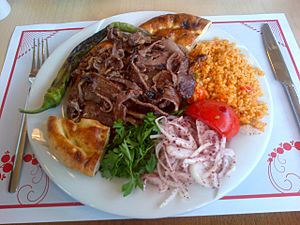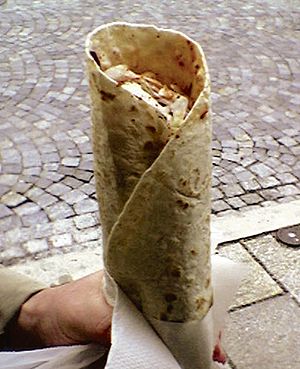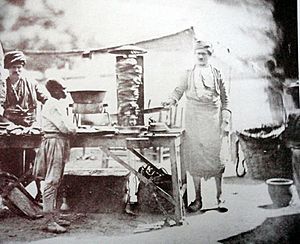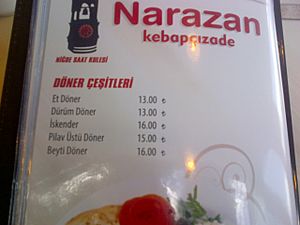Doner kebab facts for kids
The doner kebab is a tasty Turkish dish. It's made from lamb, chicken, or beef. The meat is cooked slowly on a tall, spinning grill called a vertical rotisserie. As it cooks, thin slices are cut off. When you buy a doner kebab, it often comes with fresh salad or crispy french fries.
Traditionally, Turkish restaurants offer hot chili sauce and a creamy garlic yogurt sauce. Other popular sauces include barbecue sauce, burger sauce, lemon juice, or a mint sauce.
Doner kebabs are often enjoyed as take-away food, especially after a fun night out. There are a few common ways to eat them:
- Wrapped in pita bread (this is the most common way).
- Served on top of pita bread.
- As a plate of "doner meat" (often with chips), usually with salad.
- Often topped with sauces like tomato ketchup, mayonnaise, chili sauce, mint, or garlic sauce.
Even though it's from Turkey, doner kebab is super popular in Germany. It was first brought to Germany in the 1970s.
Contents
History of Doner Kebab
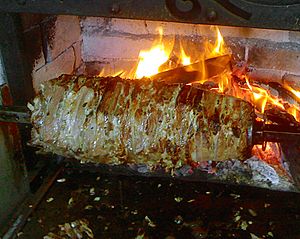
People have been cooking seasoned meat on a grill for a long time. In the Ottoman Empire, as far back as the 1600s, meat was cooked on a horizontal rotisserie. This was similar to today's cağ kebab.
The idea of cooking meat on a vertical rotisserie came later, around the mid-1800s. Many believe the town of Bursa in Turkey is where the vertical döner kebab was first made. A person named Yavuz İskenderoğlu says his grandfather, İskender Efendi, had the idea in the 1850s. He decided to cook lamb vertically instead of horizontally at his father's restaurant. It was a big hit and later became known as döner kebap. Another person, Hamdi Usta from Kastamonu, might have done it even earlier, around 1830.
Later, an Arab version called shawarma became popular. By the 1930s, Lebanese immigrants brought it to Mexico, where it was sold in restaurants. Doner kebab probably came to Greece in the 1920s. There, it changed into what we now call gyros.
It took about 100 years for döner kebab to become popular in Istanbul. A famous chef named Beyti Güler helped make it well-known. His restaurant, which opened in 1945, became famous. It served döner and other kebab dishes to important people like kings, prime ministers, and movie stars. People started eating döner kebab in a sandwich form in Istanbul by the mid-1960s.
The döner kebab, especially as a "fast food" sandwich, became famous worldwide in the mid to late 1900s. The first doner kebab shop in London opened in 1966. By the late 1970s, they were common in many UK cities. Gyros was already popular in Greece and New York City by 1971. A Canadian version, the donair, started in 1972. It even became the official food of Halifax! In Mexico, the taco al pastor developed from shawarma by the 1960s.
In Germany, Turkish workers helped make döner kebab popular in Berlin in the early 1970s. There, it changed into a special sandwich with lots of salad, vegetables, and sauces. It was sold in big portions for a good price. Soon, it became one of the most popular fast food and street food dishes in Germany and much of Europe, and it's now loved around the world.
Doner Kebab in the UK
In the UK, kebabs are a big part of Friday and Saturday night fun, rather than a breakfast or lunch meal. UK doner kebab often uses different spices because many shops are run by people from Northern Cyprus. These shops might offer doner, shish (lamb and chicken), and kofte kebabs. A "special" might include a mix of these with bread and chips.
Doner Kebab in Canada
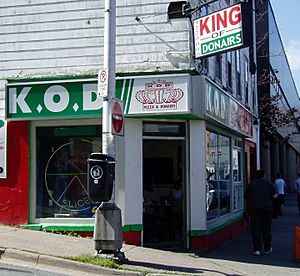
A special version called donair started in Halifax, Canada, in the early 1970s. There are different stories about how it began. One story says that a Greek immigrant named Peter Gamoulakos started selling Greek-style gyros in Halifax. People didn't really like it at first. So, in 1972, he changed the recipe. He used spiced ground beef instead of pork and lamb, put it in Lebanese flatbread, and created a unique sweet donair sauce. This sauce is made with condensed milk, vinegar, sugar, and garlic. He called it "doner," but people started saying and spelling it as "donair." In 1973, Gamoulakos opened the first King of Donair restaurant. In 2015, Halifax officially named donair the city's official food! While it used to be mostly found in Atlantic Canada, it's now popular in other parts of Canada too.
Doner Kebab in the United States
In the United States, doner kebab is best known as its Greek version, called gyros. Many people claim to have brought this dish to the US in the 1960s. It started being made in large amounts in the 1970s. In Greece, it was originally called ντονέρ (doner). But by 1970 in the US, the new name gyros was commonly used. Some Greek restaurants still used both names into the 1970s. It was also available in some Turkish restaurants, possibly later. In recent years, many restaurants and food trucks that specialize in döner kebab have opened across the country. A lot of these are owned by German immigrants.
Doner Kebab in Australia
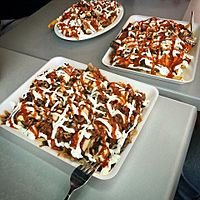
Australia has people from many different cultures. Because of this, the doner kebab competes with the Greek gyros and the Lebanese shawarma. Kebab sellers in Australia must follow strict government rules to keep food safe.
A special dish called a halal snack pack started in Australia. It has halal-certified doner kebab meat, chips (french fries), and sauces like chili, garlic, and barbecue. It's usually served in a styrofoam container. This dish is a common item at kebab shops in Australia. The name "halal snack pack" was even chosen as the "People's choice Word of the Year" in 2016 by the Macquarie Dictionary.
Health and Safety
Sometimes, there are concerns about doner kebab, like how the meat is stored overnight or reheated. People also wonder about the quality of the meat and if it has too much salt, fat, or calories. Some checks have found that the meat might not always be what was advertised.
Most developed countries have rules about Food safety to prevent bacteria in undercooked meat. Some countries even have specific rules for handling and preparing döner kebab. For example, after some cases of E. coli food poisoning, the Canadian government in 2008 suggested that the meat should be cooked a second time after being sliced from the rotisserie. In Germany, any döner kebab meat put on the rotisserie must be sold on the same day. It's against health rules to freeze meat that's only partly cooked to sell later.
Images for kids
See also
 In Spanish: Döner para niños
In Spanish: Döner para niños


